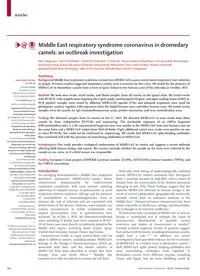
2014 Middle East respiratory syndrome coronavirus in dromedary camels_ an outbreak investigation PDF
Preview 2014 Middle East respiratory syndrome coronavirus in dromedary camels_ an outbreak investigation
140 www.thelancet.com/infection Vol 14 February 2014 Articles Middle East respiratory syndrome coronavirus in dromedary camels: an outbreak investigation Bart L Haagmans*, Said H S Al Dhahiry*, Chantal B E M Reusken*, V Stalin Raj*, Monica Galiano, Richard Myers, Gert-Jan Godeke, Marcel Jonges, Elmoubasher Farag, Ayman Diab, Hazem Ghobashy, Farhoud Alhajri, Mohamed Al-Thani, Salih A Al-Marri, Hamad E Al Romaihi, Abdullatif Al Khal, Alison Bermingham, Albert D M E Osterhaus, Mohd M AlHajri, Marion P G Koopmans Summary Background Middle East respiratory syndrome coronavirus (MERS-CoV) causes severe lower respiratory tract infection in people. Previous studies suggested dromedary camels were a reservoir for this virus. We tested for the presence of MERS-CoV in dromedary camels from a farm in Qatar linked to two human cases of the infection in October, 2013. Methods We took nose swabs, rectal swabs, and blood samples from all camels on the Qatari farm. We tested swabs with RT-PCR, with amplifi cation targeting the E gene (upE), nucleocapsid (N) gene, and open reading frame (ORF) 1a. PCR positive samples were tested by diff erent MERS-CoV specifi c PCRs and obtained sequences were used for phylogentic analysis together with sequences from the linked human cases and other human cases. We tested serum samples from the camels for IgG immunofl uorescence assay, protein microarray, and virus neutralisation assay. Findings We obtained samples from 14 camels on Oct 17, 2013. We detected MERS-CoV in nose swabs from three camels by three independent RT-PCRs and sequencing. The nucleotide sequence of an ORF1a fragment (940 nucleotides) and a 4·2 kb concatenated fragment were very similar to the MERS-CoV from two human cases on the same farm and a MERS-CoV isolate from Hafr-Al-Batin. Eight additional camel nose swabs were positive on one or more RT-PCRs, but could not be confi rmed by sequencing. All camels had MERS-CoV spike-binding antibodies that correlated well with the presence of neutralising antibodies to MERS-CoV. Interpretation Our study provides virological confi rmation of MERS-CoV in camels and suggests a recent outbreak aff ecting both human beings and camels. We cannot conclude whether the people on the farm were infected by the camels or vice versa, or if a third source was responsible. Funding European Union projects EMPERIE (contract number 223498), ANTIGONE (contract number 278976), and the VIRGO consortium. Introduction An emerging betacoronavirus—Middle East respiratory syndrome coronavirus (MERS-CoV)—causes illness characterised predominantly by mild-to-severe respiratory complaints, with most patients requiring admission to hospital because of pneumonitis or acute respiratory distress syndrome. Old age and the presence of comorbidities or immunosuppression seem to increase the risk of infection and are associated with severe forms of the disease. However, some patients can remain asymptomatic or mildly symptomatic and atypical presentations such as gastroenteritis have occurred.1 As of Dec 2, 2013, 163 laboratory-confi rmed cases, including 71 deaths, have been reported to WHO.2 All of these cases were directly or indirectly linked to the Middle East region, including Saudi Arabia, Qatar, United Arab Emirates, Kuwait, Oman, and Jordan. Coronaviruses reside in many animal hosts and can adapt to diff erent species, including people. MERS-CoV belongs to the lineage C betacoronaviruses, which are associated with bats3 and the closest relatives of MERS-CoV have been identifi ed in vesper bats from Europe, Asia, and South Africa.4–6 Notably, this coronovirus is able to replicate in various bat cell lines.7 Molecular clock dating of epidemiologically unlinked human MERS-CoV isolates estimated their divergence from a common ancestor in mid-2011, with a cluster of isolates from the eastern parts of the Arabian peninsula diverging in late 2012. These fi ndings suggest that the reported MERS-CoV diversity in human beings is the result of several independent, geographically structured, zoonotic events from an unknown reservoir in the Middle East.8,9 Human-to-human transmission has been noted, especially in health-care settings and households, but is thought to be relatively ineffi cient.1 To determine how circulation of MERS-CoV in human beings is maintained and to mitigate the chain of transmission, identifi cation of possible animal reservoirs and modes of transmission is needed.10 Limited available exposure history of patients suggest that contact with livestock, including dromedary camels, might have a role.1,9,11,12 In addition, our recent investigations have provided evidence for the circulation of MERS-CoV or a related virus in dromedary camels.13 Both MERS-CoV spike protein binding antibodies and virus neutralising antibodies were reported in dromedary camels from diff erent regions, including Oman and Egypt, but no virus shedding could be Lancet Infect Dis 2014; 14: 140–45 Published Online December 17, 2013 http://dx.doi.org/10.1016/ S1473-3099(13)70690-X See Comment page 93 *Authors contributed equally Department of Viroscience, Erasmus Medical Center, Rotterdam, Netherlands (B L Haagmans PhD, V S Raj PhD, Prof A D M E Osterhaus PhD, Prof M P G Koopmans PhD); Department of Laboratory Medicine and Pathology, Hamad Medical Corporation, Doha, Qatar (S H S Al Dhahiry PhD); Centre for Infectious Disease Research, Diagnostics and Screening, Division of Virology, National Institute for Public Health and the Environment, Bilthoven, Netherlands (C B E M Reusken PhD, G-J Godeke BSc, M Jonges MSc, M P G Koopmans); Virus Reference Department, Public Health England, London, UK (M Galiano PhD, R Myers PhD, A Bermingham PhD); and Supreme Council of Health, Doha, Qatar (E Farag MPH, A Diab MPH, H Ghobashy PhD, F Alhajri BSc, M Al-Thani ABCM, S A Al-Marri ABFM, H E Al Romaihi ABCM, A Al Khal PhD, M M AlHajri ABCM) Correspondence to: Dr Mohd M AlHajri, Supreme Council of Health, PO Box 42, Doha, Qatar
